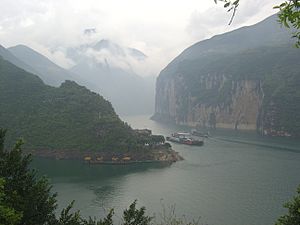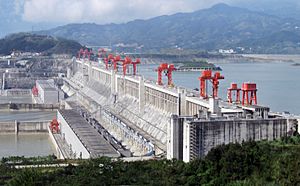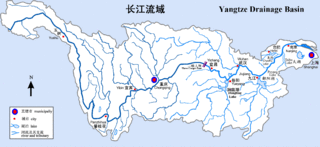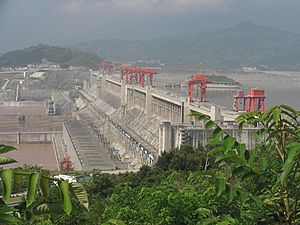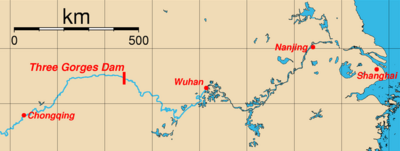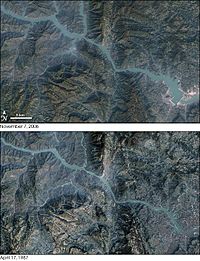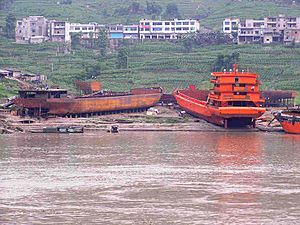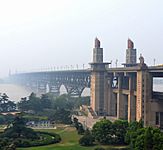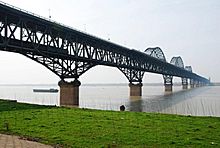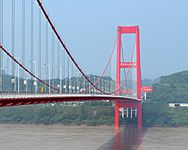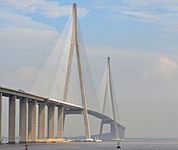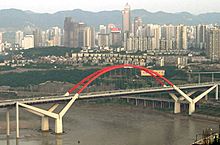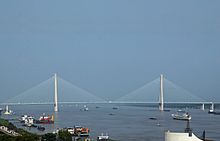Yangtze River facts for kids
Quick facts for kids Yangtze River |
|
|---|---|
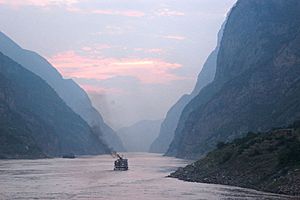
Dusk on the middle reaches of the Yangtze River (Three Gorges) 2002
|
|
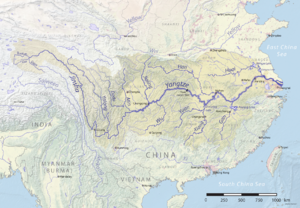
Map of the Yangtze River drainage basin
|
|
| Country | China |
| Provinces | Qinghai, Yunnan, Sichuan, Hubei, Hunan, Jiangxi, Anhui, Jiangsu |
| Municipalities | Chongqing and Shanghai |
| Autonomous region | Tibet |
| Cities | Luzhou, Chongqing, Yichang, Jingzhou, Yueyang, Wuhan, Jiujiang, Anqing, Tongling, Wuhu, Nanjing, Zhenjiang, Yangzhou, Nantong, Shanghai |
| Physical characteristics | |
| Main source | Dam Qu (Jari Hill) Tanggula Mountains, Qinghai 5,170 m (16,960 ft) 32°36′14″N 94°30′44″E / 32.60389°N 94.51222°E |
| 2nd source | Ulan Moron 33°23′40″N 90°53′46″E / 33.39444°N 90.89611°E |
| 3rd source | Chuma'er River 35°27′19″N 90°55′50″E / 35.45528°N 90.93056°E |
| 4th source | Muluwusu River 33°22′13″N 91°10′29″E / 33.37028°N 91.17472°E |
| 5th source | Bi Qu 33°16′58″N 91°23′29″E / 33.28278°N 91.39139°E |
| River mouth | East China Sea Shanghai and Jiangsu 31°23′37″N 121°58′59″E / 31.39361°N 121.98306°E |
| Length | 6,300 km (3,900 mi) |
| Discharge (location 2) |
|
| Basin features | |
| Basin size | 1,808,500 km2 (698,300 sq mi) |
| Tributaries |
|
| Chang Jiang | |||||||||||||||||||||||||||||||||||||
|---|---|---|---|---|---|---|---|---|---|---|---|---|---|---|---|---|---|---|---|---|---|---|---|---|---|---|---|---|---|---|---|---|---|---|---|---|---|

"Yangtze River (Cháng jiāng)" in Simplified (top) and Traditional (bottom) Chinese characters
|
|||||||||||||||||||||||||||||||||||||
| Chinese name | |||||||||||||||||||||||||||||||||||||
| Simplified Chinese | 长江 | ||||||||||||||||||||||||||||||||||||
| Traditional Chinese | 長江 | ||||||||||||||||||||||||||||||||||||
| Literal meaning | long river | ||||||||||||||||||||||||||||||||||||
|
|||||||||||||||||||||||||||||||||||||
| Yangtze River | |||||||||||||||||||||||||||||||||||||
| Simplified Chinese | 扬子江 | ||||||||||||||||||||||||||||||||||||
| Traditional Chinese | 揚子江 | ||||||||||||||||||||||||||||||||||||
|
|||||||||||||||||||||||||||||||||||||
| Tibetan name | |||||||||||||||||||||||||||||||||||||
| Tibetan | འབྲི་ཆུ་ | ||||||||||||||||||||||||||||||||||||
|
|||||||||||||||||||||||||||||||||||||
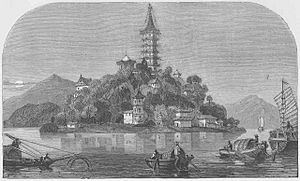
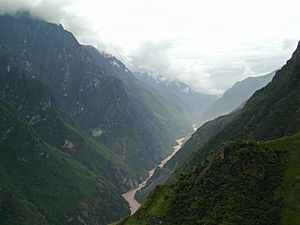
The Yangtze River, also called Yangzi or Chang Jiang, is the longest river in China and Asia. It is the third-longest river in the world. The Yangtze is also the longest river in the world that flows entirely within one country.
This amazing river starts high up in the Tanggula Mountains on the Tibetan Plateau. It flows for about 6,300 kilometres (3,900 mi) towards the east. Finally, it empties into the East China Sea. The Yangtze is one of the world's largest rivers by the amount of water it carries.
The river's drainage basin (the area of land where all the water drains into the river) covers one-fifth of China. Nearly one-third of China's population lives in this area.
For thousands of years, the Yangtze River has been super important for China. People have used it for water, farming, cleaning, and travel. It has also been a key area for trade and even wars. The rich Yangtze Delta area, where the river meets the sea, produces a lot of China's wealth.
The Three Gorges Dam on the Yangtze is the largest hydroelectric power station in the world. It creates electricity using the power of water. In 2014, China started building a huge transport network along the river. This includes railways, roads, and airports. The goal is to create a new economic hub along the river.
The Yangtze River flows through many different natural areas. It is home to several unique and endangered animals. These include the Chinese alligator and the Yangtze finless porpoise. Sadly, the Chinese river dolphin (or baiji) and the Chinese paddlefish are now extinct. The Dabry's sturgeon is also extinct in the wild.
In recent years, the river has faced big problems. These include pollution from factories and plastic. Farm chemicals and too much dirt (silt) also harm the river. Many wetlands and lakes have been lost, which makes seasonal floods worse. To protect the river, some parts are now nature reserves. A part of the river in Yunnan is even a UNESCO World Heritage Site.
Contents
What's in a Name?
The official Chinese name for the Yangtze River is Cháng Jiāng. This name means "Long River." In ancient times, the river was simply called Jiang. Later, people started calling it the "Great River" (Dàjiāng).
Different parts of the Yangtze River have their own local names. For example, the section flowing through Sichuan and Chongqing is sometimes called the "Sichuan River." The "Jinsha River" (Gold Sands River) is the name for a long part of the river upstream. Even further upstream, it's called the "Tongtian River" (River that leads to Heaven).
Where the Yangtze Flows
The Yangtze River begins in the eastern part of the Tibetan Plateau. It flows east through Qinghai province. Then, it turns south and goes down a deep valley between Sichuan and Tibet. In this valley, the river drops from over 5,000 m (16,000 ft) to less than 1,000 m (3,300 ft).
The river enters the Sichuan basin at Yibin. Here, many strong rivers join it, making its water volume much larger. It then cuts through Mount Wushan, creating the famous Three Gorges. East of the Three Gorges, Yichang is the first city on the flat Yangtze Plain.
As it enters Hubei province, the Yangtze gets water from many lakes. The biggest is Dongting Lake, which is on the border of Hunan and Hubei. At Wuhan, the Han River joins the Yangtze. This brings water from as far north as Shaanxi.
Further downstream, Poyang Lake, China's largest freshwater lake, flows into the Yangtze. The river then goes through Anhui and Jiangsu provinces. It collects water from many smaller lakes and rivers. Finally, it reaches the East China Sea at Shanghai.
Four of China's five main freshwater lakes add their water to the Yangtze River. The river is often divided into three parts:
- The upstream part is from Yibin to Yichang.
- The middle part is from Yichang to Hukou County.
- The downstream part is from Hukou to Shanghai.
Yangtze River History
The Yangtze River is very important to the history and culture of southern China and Japan. People lived in the Three Gorges area as far back as 27,000 years ago. By 5000 BC, the lower Yangtze was a major place for people to live. Early cultures like the Hemudu and Majiabang grew rice here.
The Yangtze has always been key for China's water transport. This was especially true for almost 2,000 years. It was vital until railways were built in the 20th century. The Grand Canal connects the lower Yangtze to major cities like Wuxi and Suzhou. It also links to northern China, all the way to Beijing.
River Flow and Floods
Tens of millions of people live in the Yangtze valley's floodplain. This area naturally floods every summer. People can live there only because of river dikes (walls built to hold back water). But sometimes, floods are so big they go over the dikes. This causes huge problems for people living and farming there. Big floods happened in 1931, 1954, and 1998.
Dams on the Yangtze
As of 2007, two main dams were built on the Yangtze River itself: the Three Gorges Dam and the Gezhouba Dam. The Three Gorges Dam is the largest power station in the world. It can produce 22.5 gigawatts of electricity.
Many other dams are being built or are already working on the upper part of the river, called the Jinsha River. The Xiluodu Dam is the third largest power station in the world. The Baihetan Dam, which opened in 2021, is the second largest after the Three Gorges Dam.
River Pollution and Protection
Starting in the 1950s, many dams and dikes were built. These were meant to control floods, create new land, and help with farming. More than a hundred lakes were cut off from the main river. Farmers and towns built homes near these lakes, even though it was not allowed.
When floods came, it was hard to open the gates to these lakes. This would have caused a lot of damage. So, many lakes partly or completely dried up. For example, Baidang Lake shrunk a lot. Only a few large lakes, like Poyang Lake and Dongting Lake, stayed connected to the Yangtze. In 2012, the Yangtze River near Chongqing even turned red from pollution.
The Three Gorges Dam has also created a barrier. This has greatly reduced the number of different animals in the river. Some animals, like the Chinese river dolphin and the Yangtze finless porpoise, faced immediate danger. In 2006, the Chinese river dolphin became extinct. This meant the world lost an entire type of animal.
In 2020, the Chinese government passed a new law. This law aims to protect the river's environment. It includes:
- Stronger rules for hydropower projects.
- Banning chemical factories near the river.
- Moving polluting industries away.
- Strictly limiting sand mining.
- A complete ban on fishing in all natural waterways of the river.
Plastic in the Ocean
The Yangtze River carries more plastic into the ocean than any other river. This is according to The Ocean Cleanup, a group that studies ocean pollution. The Yangtze, along with 9 other rivers, carries 90% of all the plastic that ends up in the oceans.
Connecting Lakes Again
In 2002, a project started to connect lakes back to the Yangtze. The goal was to increase the number of different animals and help with flooding. The first lakes reconnected in 2004 were Zhangdu Lake, Honghu Lake, and Tian'e-Zhou. In 2005, Baidang Lake was also reconnected.
Connecting the lakes again made the water cleaner. Fish could swim from the river into the lakes. This helped their numbers grow and improved their genes. By 2010, many protected areas were set up. These areas helped increase the populations of 47 threatened species. This included the critically endangered Yangtze alligator. In Shanghai, new wetlands now protect the city's drinking water. There are plans to connect even more areas along the Yangtze.
Major Cities Along the River
Many important cities are located along the Yangtze River:
Rivers that Join the Yangtze
The Yangtze River has over 700 smaller rivers that flow into it. These are called tributaries. Here are some of the major ones, listed from upstream to downstream:
- Yalong River (joins at Panzhihua, Sichuan)
- Min River (joins at Yibin, Sichuan)
- Tuo River (joins at Luzhou, Sichuan)
- Chishui River (joins at Hejiang, Sichuan)
- Jialing River (joins at Chongqing)
- Wu River (joins at Fuling, Chongqing)
- Qing River (joins at Yidu, Hubei)
- Yuan River (flows into Dongting Lake)
- Lishui River (flows into Dongting Lake)
- Zi River (flows into Dongting Lake)
- Xiang River (joins at Yueyang, Hunan)
- Han River (joins at Wuhan, Hubei)
- Gan River (near Jiujiang, Jiangxi)
- Shuiyang River (joins at Dangtu, Anhui)
- Qingyi River (joins at Wuhu, Anhui)
- Chao Lake water system (joins at Chaohu, Anhui)
- Lake Tai water system (joins at Shanghai)
Wildlife in the Yangtze
The Yangtze River is home to many different kinds of animals and plants. Many of these are unique to the river and are seriously threatened by human activities.
Fish Species
As of 2011, there were 416 known fish species in the Yangtze River basin. This makes it one of the richest rivers in Asia for fish. 178 of these fish species are found only in the Yangtze River Basin. The upper part of the river, above Yichang, is especially rich in unique fish.
Many Yangtze fish species have greatly decreased in number. 65 were listed as threatened in 2009. Three species are now completely extinct: the Chinese paddlefish, Anabarilius liui liui, and Atrilinea macrolepis. Two are extinct in the wild: Anabarilius polylepis and Schizothorax parvus. Both the Dabry's sturgeon and Chinese sturgeon are critically endangered. Their survival might depend on people raising them and releasing them into the wild.
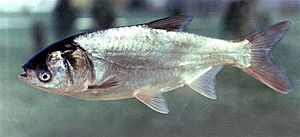
The biggest threats to the Yangtze's native fish are too much fishing and loss of their homes. Dams also cause big problems because many fish need to migrate to breed. Most of these fish cannot jump over dams like salmon can. For example, the Gezhouba Dam stopped the migration of the paddlefish and two sturgeon species.
While many native fish are threatened, others are important for fish farming. A total of 26 native fish species from the Yangtze basin are farmed. Important ones include four types of Asian carp: grass carp, black carp, silver carp, and bighead carp.
Other Animals

Besides fish, the Yangtze is home to several large, seriously threatened animals. These include the Yangtze finless porpoise, Chinese alligator, Yangtze giant softshell turtle, and Chinese giant salamander. The Yangtze is the only place outside the United States that has both an alligator and a paddlefish species.
In 2006, the Chinese river dolphin was declared functionally extinct. This means there were no signs of them left in the river. In 2007, a large, white animal was seen and photographed. People thought it might be a baiji, but there have been no confirmed sightings since 2004. So, the baiji is now presumed functionally extinct. Some believe the extinction of the Yangtze river dolphin was caused by the Three Gorges Dam.
Many land mammals live in the Yangtze valley. A few are directly linked to the river, like the Eurasian otter, water deer, and Père David's deer.
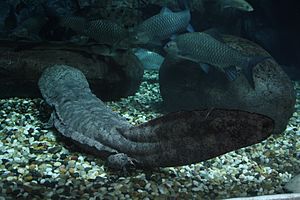
Besides the rare Yangtze giant softshell turtle, several smaller turtle species live in the Yangtze basin. These include the Chinese box turtle and yellow pond turtle. All of these are considered threatened.
Over 160 types of amphibians are found in the Yangtze basin. This includes the world's largest, the critically endangered Chinese giant salamander. Its numbers have dropped a lot because of hunting, loss of its home, and pollution.
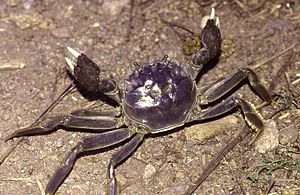
The Yangtze basin has many types of freshwater crabs. The Chinese mitten crab is important for business in the Yangtze. However, it has spread to Europe and North America, where it is considered an invasive species.
The freshwater jellyfish Craspedacusta sowerbii also comes from the Yangtze. It is now an invasive species in many parts of the world.
Fun Facts About the Yangtze
- Historically, the Yangtze often formed the border between northern and southern China. This was because it was so hard to cross.
- Many battles happened along the river. The most famous was the Battle of Red Cliffs in 208 AD.
- The Jardine was the first steamship to sail the river in 1835.
- The first bridge across the Yangtze River was built from 1955 to 1957. Soviet engineers helped build it.
- In August 2019, Ash Dykes became the first person to walk the entire 4,000-mile (6,437 km) length of the river. He walked for 352 days from its source to its mouth.
Images for kids
-
The Nanjing Yangtze River Bridge, a beam bridge, was completed in 1968.
-
The Yichang Yangtze Highway Bridge, a suspension bridge near the Gezhouba Dam lock, was completed in 1996.
-
The Sutong Yangtze River Bridge, between Nantong and Suzhou, was one of the longest cable-stayed bridges in the world when it was completed in 2008.
See also
 In Spanish: Yangtsé para niños
In Spanish: Yangtsé para niños


